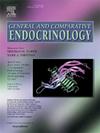In vitro effects of 11-deoxycorticosterone on hepatocytes and gill epithelial cells of rainbow trout (Oncorhynchus mykiss)
IF 1.7
3区 医学
Q3 ENDOCRINOLOGY & METABOLISM
引用次数: 0
Abstract
The 11-deoxycorticosterone (DOC) corticosteroid has been recently described as having a potential role in fish, complementing cortisol action through distinct physiological effects. Although systemic effects of 11-deoxycorticosterone (DOC) have been reported, the specific mechanisms mediated through glucocorticoid (GR) and mineralocorticoid (MR) receptors remain poorly understood. Therefore, we evaluated the DOC effects through both receptors in rainbow trout hepatoma-derived (RTH-149) and gill epithelial (RTgill-W1) cell lines. Cultures were pretreated with GR (Mifepristone) or MR (Eplerenone) antagonists for 1 h (50 nM) and then with DOC (10 nM) or vehicle (DMSO-PBS1X) as control for 3 h (n = 3). First, to determine a DOC-induced response via GR or MR, we detected a decrease in transcriptional levels of mr and these results were recovered to basal levels by MR antagonist in both cell lines. Then, we evaluated different metabolites and solutes associated with carbohydrate metabolism in RTH-149 and osmoregulation in RTgill-W1, detecting that DOC through both GR and MR differentially modulates lactate, glycogen, calcium, and chloride levels. We also identified that DOC mainly by MR differentially regulates gene expression of glucose/glycogen metabolism in RTH-149, ionic cotransporters, and tight junction proteins in RTgill-W1. Subsequently, we determined that DOC significantly decreases glucose uptake in RTH-149 and apparent permeability in RTgill-W1, reversed by MR antagonist. However, DOC does not affect transepithelial resistance in RTgill-W1. This study provides the first evidence that DOC, primarily via MR, plays a role in regulating carbohydrate metabolism in fish hepatocytes and osmoregulation in gill epithelial cells.
11-脱氧皮质酮对虹鳟鱼肝细胞和鳃上皮细胞的体外影响
11-脱氧皮质酮(DOC)皮质类固醇最近被描述为在鱼类中具有潜在的作用,通过不同的生理作用补充皮质醇的作用。尽管已经报道了11-脱氧皮质酮(DOC)的全身作用,但通过糖皮质激素(GR)和矿皮质激素(MR)受体介导的具体机制仍然知之甚少。因此,我们通过两种受体在虹鳟鱼肝癌源性(RTH-149)和鳃上皮(RTgill-W1)细胞系中评估了DOC的作用。用GR(米非司酮)或MR(依普利酮)拮抗剂预处理1小时(50 nM),然后用DOC (10 nM)或载体(DMSO-PBS1X)作为对照预处理3小时(n = 3)。首先,为了通过GR或MR确定doc诱导的应答,我们检测到MR转录水平的下降,MR拮抗剂在两种细胞系中将这些结果恢复到基础水平。然后,我们评估了RTH-149中与碳水化合物代谢和rtggil - w1中的渗透调节相关的不同代谢物和溶质,发现DOC通过GR和MR对乳酸、糖原、钙和氯化物水平进行了差异调节。我们还发现,以MR为主的DOC对RTH-149中葡萄糖/糖原代谢、RTgill-W1中离子共转运蛋白和紧密连接蛋白的基因表达有差异调节。随后,我们确定DOC显著降低RTH-149的葡萄糖摄取和RTgill-W1的表观通透性,被MR拮抗剂逆转。然而,DOC不影响RTgill-W1的上皮耐药。本研究首次证明DOC主要通过MR参与鱼肝细胞碳水化合物代谢和鳃上皮细胞渗透调节。
本文章由计算机程序翻译,如有差异,请以英文原文为准。
求助全文
约1分钟内获得全文
求助全文
来源期刊

General and comparative endocrinology
医学-内分泌学与代谢
CiteScore
5.60
自引率
7.40%
发文量
120
审稿时长
2 months
期刊介绍:
General and Comparative Endocrinology publishes articles concerned with the many complexities of vertebrate and invertebrate endocrine systems at the sub-molecular, molecular, cellular and organismal levels of analysis.
 求助内容:
求助内容: 应助结果提醒方式:
应助结果提醒方式:


